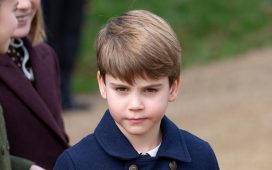KODIAK, Alaska (AP) – After several years of planning, fundraising and landscaping, a dedication and ribbon-cutting ceremony was held at the Alutiiq Ancestors Memorial , heralding the official opening of the park to the public.
The park is on a 0.34 acre stretch of city-owned land along Upper Mill Bay Road, between East Rezanof Drive and Kashevaroff Avenue. It has been landscaped with lawns and plants and several winding pathways, which culminate at a central, circular stone planter surrounded by benches.
According to the Alutiiq Museum Chief Curator Amy Steffian, circles are an important symbol in Alutiiq culture and art. She said they can represent the universe and passageways between the human and spirit world, and are also symbolic of vision and awareness. Near the bottom end of the park is a recently installed archway, a finishing touch that was erected in the days just prior to the June 14 opening.
“I was looking at my calendar and realized it was almost exactly a year since we held the groundbreaking ceremony last year — of course, the weather was a lot different that time. But it made me think this has all actually happened really quickly — probably about two years total,” said April Laktonen Counceller, executive director of the Alutiiq Museum, the organization behind the memorial. “It all worked out just perfectly. I’m so happy and proud of everybody who worked together on this project.”
Counceller, who helmed the memorial project, welcomed a crowd of Kodiakans on a rainy-but-mild afternoon Friday, thanking them for attending before introducing Father Innocent Dresdow.
Dresdow conducted a blessing of the park, sprinkling holy water across the site.
“We ask your blessing upon this land, upon all those here remembered, and those who will come and learn about our island, our culture and those who went before us,” Dresdow said.
Counceller then invited Margaret Roberts, chair of the museum’s board of directors, along with Kodiak Chamber of Commerce Executive Director Sarah Phillips, to perform a ribbon cutting ceremony.
Due to the rain, the rest of the dedication was held inside the museum. It began with a speech from Roberts, who thanked all those involved in bringing the memorial together, including Counceller and the rest of the museum’s staff, all those who donated to the project, the City of Kodiak, and number of Native groups, local institutions and individuals.
Roberts went on to say a few words about the meaning of the memorial. She said that, 40 years ago, she made her first trip to Washington D.C. and visited the Smithsonian Institute’s Museum of History and Art, where Kodiak artifacts were on display.
“While learning about Kodiak Island’s prize artifacts and history, I was saddened to see human skeletal remains,” Roberts said. “Thus, the birth of the Native American Graves Protection Act came about, to return those that were taken so long ago.”
Native American Graves Protection Act was passed in 1990 and mandates entities that receive federal funding to return Native American “cultural items” to lineal descendants and culturally affiliated tribes and organizations. Cultural items include human remains, funerary objects, sacred objects and other artifacts.
The original idea for the memorial was spurred by the repatriation of the remains of 109 people from the now-non-existent Chirikof Tribe. The remains were those of Alutiiq inhabitants from Ukamuk Village on Chirikof Island, located about 80 miles southwest of Kodiak Island.
In the 1960s, U.S. Bureau of Land Management archaeologists visited Chirikof Island and found the human remains exposed and scattered along the beach, following years of erosion. To save the remains, the archaeologist excavated the site and removed the bones.
Instead of sending the remains to the parish in Kodiak, the archaeologists sent them to the Lower 48. Ultimately, they ended up at Indiana University, Bloomington, unbeknown to their descendants on Kodiak Island.
Sven Haakansan, then-director of the Alutiiq Museum, found out about the remains in 2005. A long battle to bring them home ensued. Ultimately, it required the intervention of the U.S. Fish and Wildlife Service.
The remains arrived in Kodiak in February, 2017. It was the second biggest repatriation of human remains in Kodiak-area history (the largest repatriation of human remains were when Smithsonian returned remains excavated in the 1930s from Larsen Bay) and had been a top priority of the Alutiiq Heritage Foundation for more than 15 years.
In May of that year, the Alutiiq Museum requested permission from the Kodiak City Council to inter the remains on the piece of unused city-owned land behind the museum, with the Sun’aq Tribe of Kodiak acting as the agent of repatriation. The idea was to rebury the remains and build a memorial at the site.
The museum, however, hit a snag in the form of a zoning issue that prohibited the burial of human remains on that lot. So, after being held for almost five decades by academics at Indiana University, the remains of the 109 people were reburied in the city cemetery in June, 2017.
However, the idea of creating a memorial lived on and, in August of that year, the Kodiak City Council gave the museum approval to move forward on plans to establish the park.
The museum promptly set about creating plans and a budget for the creation of the park. The museum set itself a target to raise $180,000 over the next year through donations and the sale of memorial bricks. The bricks sold for $100 to $1,000 and could be customized with a message; all those sold have been installed in the park.
The museum announced that it had surpassed its fundraising goal at a groundbreaking ceremony on June 1. For that event, Counceller was joined by members of the Alutiiq Language Club to sing the Alaska Flag song in Alutiiq. Among those in attendance was Sun’aq Tribal Council President Frank Peterson Jr., who read Jack Riemer and Rabbis Sylvan Kamens’ poem “We Remember Them.”
The final feature to be installed at the park before its opening on Friday was the archway, an art piece that was sponsored by Regional Native Corporation Koniag Inc. Titled, Cuumillallret Angilluteng — which translates as “Our Ancestors Returning” — the archway has a little over 1,200 fish on its interior sides, each representing an Alutiiq Ancestor whose remains have been returned to the archipelago for reburial.
“Today, we will honor some 1,100 of those individuals on a memorial archway,” Roberts said during the dedication. “Thus, the salmon symbolize returning home and togetherness. They remind us of the importance of bringing our ancestors back to Kodiak and remembering those who came before us individually and collectively.”
Counceller said that the arch was the brainchild of Shauna Hegna, president of Koniag Inc.
“It was really important for her to make sure there was a component of the park that visually represented the sheer number of people that we’re talking about,” Counceller said.
According to Counceller, they were looking for something that was culturally relevant, but also reconciliatory in tone, rather than dour. This is how they landed on the idea of returning salmon.
“Fish always return home,” Counceller said. “The entire inside of the archway is covered in hundreds and hundreds of cut-out salmon and they’re all pointing towards the center of the park. The circle at the center of the park represents returning to the homeland.”
During her dedication speech, Roberts said that there are numerous organizations that continue work to repatriate remains, adding that the work to bring the remains of ancestors back to their homeland is not over. She spoke of the 7,000-year history of the Alutiiq people on Kodiak Island and their resiliency in the face of various struggles: war, outbreaks of disease, and more.
“Yes, there is more work to do. We need to bring them all home. All these individuals deserve love, honor, dignity and respect, as today we celebrate the Alutiiq Memorial,” Roberts said, ending with thanks in the Alutiiq language. “Quyanaasinaq for all of you that came out for the dedication today.”
Following Roberts, Kodiak City Mayor Pat Branson said a few words, thanking all the local residents who had a hand in the project through donating money or purchasing a brick.
“What a wonderful spot to have a memorial park for Alutiiq ancestors. This city-owned lot was barren and unused when April called with the idea of turning it into a memorial park,” Branson said, before going on to describe the park as it is today. “It is a restful, peaceful and sacred spot and one in which the city is proud to have assisted in its development.”
After Counceller thanked another list of individuals and organizations — among others, she name-checked Djuna Davidson, the museum’s education and outreach coordinator, who was a primary organizer for the dedication and ribbon-cutting. Additionally, she thanked the Kodiak Alutiiq Dancers, who performed several songs in honor of the occasion.
As the event came to an end, a contented Counceller spoke briefly with the Kodiak Daily Mirror. She said that the level of support the project had received made her recognize how many Kodiakans “respect Alutiiq heritage and honor it.”
“Sometimes when you’re working in the Native community, you don’t always see the outside-looking-in perspective. And, I think that this project has shown that there is a lot of support for Alutiiq culture and heritage,” she said. “And, that’s really positive. Especially in a time when there’s a lot of crazy economics and politics, we really need something that our community can rally around.
“And, maybe just for today, that can be the park.”
___
Information from: Kodiak (Alaska) Daily Mirror, http://www.kodiakdailymirror.com
The Washington Times Comment Policy
The Washington Times welcomes your comments on Spot.im, our third-party provider. Please read our Comment Policy before commenting.








